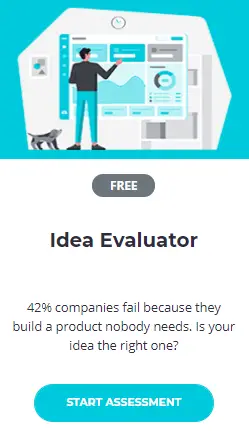How to test business ideas before launching them in the market?
Have you come up with a concept that seems like it’s going to be the “next big thing”?
You may believe your idea is great as is, but it’s always a good move to put it to the test before investing time and money into a company or product that might not take off at all.
The success of a business idea depends on its ability to be evaluated. You’re investing a lot of time, money, and other resources into launching an idea you think would be a huge success. Businesses often miss this step in their hurry to launch their product. They don’t build a business strategy or model based on market testing and analysis and instead embark on their entrepreneurial journey without a map.
Furthermore, they are unable to pinpoint who their target group is. You won’t know who would find your idea useful until people try it. Without this knowledge, your marketing efforts can fall on deaf ears, resulting in no progress with your product concept — even though it’s an outstanding one.
Business idea testing or testing your business concept is an important first step in identifying your target market and fine-tuning it to meet their real-world needs. Before you launch your product, follow these steps to ensure that it is something that the world needs.
1. Make a prototype
Even if you’re ecstatic about your latest business plan, you should probably wait a while before putting it to the test. Don’t hurry into creating a business plan or hiring a team until you’ve been through the process of writing down a bunch of ideas.
Wait a few weeks to see which ideas you remember the most. Proceed only if you have a strong conviction that the universe really requires the concept. After that, the best way to validate a business concept is to create a prototype and present it to people for truthful and genuine feedback.
2. Pose the necessary inquiries.
Ambiguous ideas and half-baked plans will almost certainly lead to a shaky start for your company. You must ask yourself the right questions in order to receive the answers you need. First, think about every aspect of your company. The questions you ask should assist you in delving deeper into your thought process and formulating a strategy. It would be easier to be competitive if you can resolve problems early on.
These are some of the things you should remember before starting a business:
- Why do I want to start a business?
- What issue am I meant to solve?
- Who is my ideal client?
- What tools do I have at my disposal?
- What are my objectives?
You should record your responses in a journal to help you remember them. After you’ve answered the general questions, you can move on to the next stage of putting your business idea to the test.
3. Build a bare-bones product
The lean startup model is an excellent way to build a particular product. Overall, you want to establish a minimum viable product (MVP). An MVP is the most basic version of your concept that you can sell as a commodity. Early in the development process, provide a version of the product to test and sell so that any modifications or improvements are in response to actual input from the target audience.
4. Understand your rivals.
You don’t want to be too engrossed in what your rivals are up to. Understanding their tactics, on the other hand, is a good idea.
Perform a business study of organizations that are similar to yours before launching your startup. You will learn what has succeeded in the past by looking at other companies. A wise business owner learns from others who have tried similar ideas before. You obtain useful information without incurring any damages as a result of a failed plan. Examining the competition will also assist you in assessing what makes your concept special.
To develop a strong customer base, you must explain how your organization is distinctive. This could be anything from introducing a new product to market to having a one-of-a-kind experience.
5. Assess your financial resources
“It requires money to make it,” as we’ve all learned. The term has become a stereotype for a purpose: it is, in the majority of cases, right. To get your company off the ground, you’ll need startup money. A variety of sources of startup capital are available. Many entrepreneurs use personal capital, such as a savings account or a credit card, to cover the costs of starting a small business. Others depend on the assistance of family and friends. Small business loans are also available from banks and private lenders.
You’ll most likely need a mix of capital solutions to finance your business. Since you have not yet developed yourself as a viable company, obtaining startup funds can be difficult. Develop a small business plan that details how you will invest the money and how much you hope to gain to persuade others that your idea is feasible.
6. Evaluate the market
Your target market is one of the best places to test your business concept. Define your ideal consumer to narrow down who would be involved in your goods or services. Then, on a small scale, perform a business study. Here are several methods for putting your business idea to the test with potential customers:
Build a focus group:
A focus group is a select group of customers who use your products and send you input. Before you go all in, use focus groups, polls, and interviews to find out what customers think.
Your target market is at your fingertips thanks to the internet. Look for online communities that may be interested in your product or service. Find out what their overall thoughts are and whether they think you can change something.
Build a crowdfunding page:
Crowdfunding platforms can be used for more than just seeking investors. You can also get user reviews, insights, and suggestions from like-minded people. Plus, you might find someone interested in investing in your concept.
7. Make a marketing strategy and stick to it
All of your preparation will be for naught if you don’t take enough steps to get a good measure of response. You must act on the interest in your viable product once you have it. Use the 100/1,000 rule as a guideline. Create a list of 100 things you can do to sell the product, and follow through on those 100 suggestions, interacting with 1,000 people in the process. You will have data on your product if you do this. You’ll know who’s interested, the marketing tactics succeeded and which didn’t, and how you can improve, both of which are crucial steps in getting your idea and company off the ground.
8. Adopt a mindset of experimentation
Too many companies are afraid of failing, so they avoid putting themselves in that situation. Sometimes, this manifests as a refusal to pursue new concepts or a reluctance to thoroughly test a product concept before releasing it. You’ll be more likely to make mistakes and try a lot of different ideas if you embrace an experimentation mentality. Since you’ll give more innovations a chance to come to life, the business model can unlock more long-term value.
Failure is seen as a positive in this case because it helps you to learn more about what works and what doesn’t in the ever-changing business environment.
9. Make design thinking a priority
The cognitive, strategic, and functional processes of designing new concepts or products are all part of design thinking. It assists innovators in redefining challenges and creating more groundbreaking solutions. In other words, it paves the way for many more innovative discoveries and innovations.
Final Thoughts
Testing the concept on a small group of people will reveal whether or not customers are interested in what you have to offer. If the small market experiments are popular, your concept has a strong chance of catching on with a wider audience.
Unfortunately, there is no way to determine whether or not an organization can succeed. Each startup story is different, and getting a project off the ground requires careful planning, the right promotional strategies, and sufficient funding. When it comes down to it, consider this: if you produce a high-quality offering that solves an issue and represents your interests, you will make a profit.
If you have just started a business or planning to start one very soon, use our AI-powered business assessments to help you make fast well-informed decisions on every aspect of the business.
If you enjoyed reading this article on how to start a business with no money, you should definitely check out more of our articles on our blog.
Frequently Asked Questions: Evaluating Your Business Concept
Q1: Why is it important to test my business idea before investing time and money into it? A: Testing your business idea allows you to assess its viability and potential for success in the market. By conducting evaluations and gathering feedback, you can identify flaws, make necessary improvements, and ensure that your concept aligns with the needs of your target audience. This step helps mitigate risks and increases the chances of launching a successful product or service.
Q2: How can I validate my business concept? A: Validating your business concept involves several steps, including:
- Creating a prototype: Develop a tangible representation of your idea and gather feedback from potential users.
- Asking the right questions: Explore various aspects of your business, such as your motivations, the problem you aim to solve, your target market, available resources, and objectives. Document your responses for reference.
- Building a minimum viable product (MVP): Develop a basic version of your concept that can be tested and sold to gather real-world feedback and refine your offering.
- Understanding your competitors: Conduct a thorough analysis of similar businesses to learn from their successes and differentiate your idea.
- Evaluating your financial resources: Assess the capital required to start your business and explore funding options like personal savings, loans, or support from family and friends.
- Assessing the market: Define your target market and conduct market research through focus groups, surveys, interviews, or crowdfunding platforms to gauge interest and gather insights.
- Creating a marketing strategy: Develop a comprehensive plan to promote your product or service and engage potential customers.
- Embracing experimentation: Adopt a mindset that encourages trying new ideas and learning from failures to drive innovation and long-term success.
- Prioritizing design thinking: Utilize a cognitive and strategic approach to refine and enhance your concepts and solutions.
Q3: How can I determine if my product solves an actual problem? A: To determine if your product solves a genuine problem, engage with potential customers through surveys, interviews, focus groups, or social media platforms. Seek their feedback, understand their pain points, and assess how well your offering addresses those issues. By validating the problem-solution fit, you can ensure that your product or service meets a real need in the market.
Q4: What should I consider when developing a marketing strategy? A: When creating a marketing strategy, it’s essential to:
- Identify your target audience: Define your ideal customer and understand their preferences, behaviors, and needs.
- Establish clear goals: Determine what you want to achieve through your marketing efforts, such as increasing brand awareness, driving sales, or expanding your customer base.
- Utilize multiple channels: Select appropriate marketing channels to reach your target audience effectively, including social media, content marketing, email marketing, advertising, and public relations.
- Track and measure results: Implement analytics tools to monitor the performance of your marketing campaigns and adjust your strategy accordingly.
- Engage with your audience: Build relationships with potential customers by providing value, addressing their concerns, and encouraging feedback and interaction.
- Continuously improve: Regularly assess the success of your marketing activities and make data-driven adjustments to optimize your approach and increase your chances of success.
Q5: Is failure a part of the process? A: Yes, failure is often a natural part of the entrepreneurial journey. Embracing failure allows you to learn from mistakes, pivot when necessary, and refine your business concept. By adopting an experimental mindset and being open to trying new ideas, you increase your chances of discovering innovative solutions and unlocking long-term value. Remember, failure can provide valuable insights and contribute to your overall growth as an entrepreneur.
Q6: How can design thinking benefit my business concept? A: Design thinking involves the cognitive, strategic, and functional processes of developing new concepts or products. By incorporating design thinking into your business concept, you can redefine challenges, generate innovative solutions, and improve user experiences. This approach encourages a human-centered perspective, ensuring that your offering addresses the real needs and desires of your target audience. Design thinking can lead to breakthrough discoveries, enhanced user satisfaction, and a competitive advantage in the market.
Q7: Can I guarantee the success of my business idea? A: Unfortunately, there are no guarantees when it comes to the success of a business idea. Each startup story is unique, and success depends on various factors, including market conditions, competition, execution, and timing. While thorough planning, effective marketing strategies, and adequate funding increase the likelihood of success, it’s important to acknowledge that entrepreneurial ventures always carry a degree of risk. However, by following the steps outlined in this post, conducting proper market research, and continuously refining your concept based on feedback, you can increase your chances of building a profitable and sustainable business.











